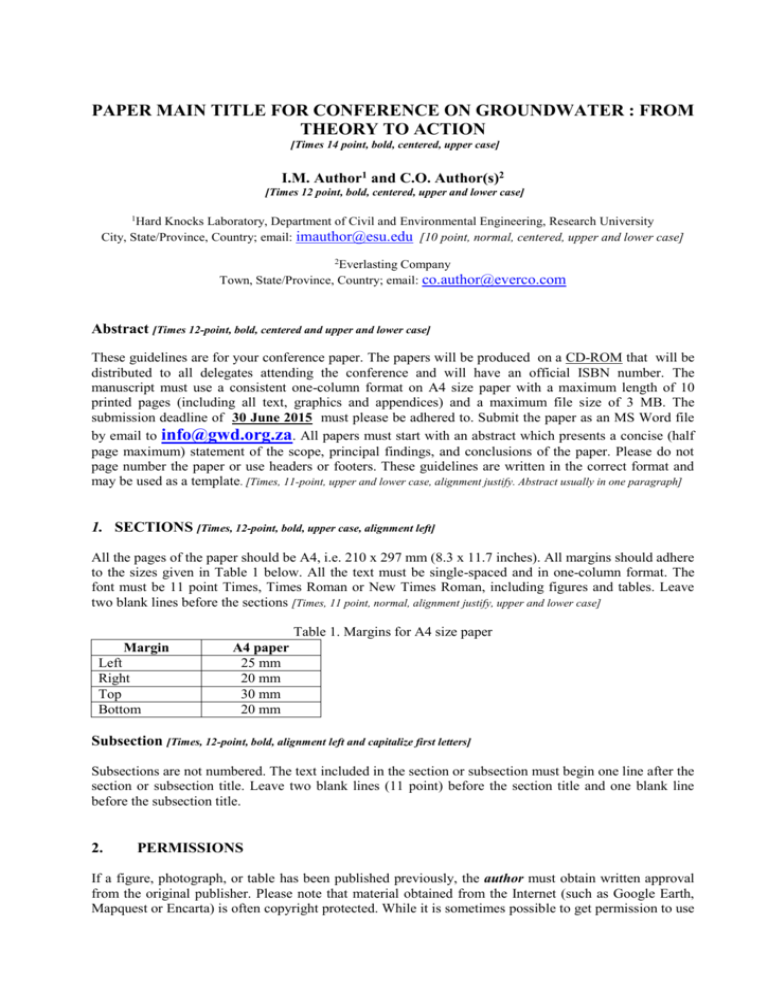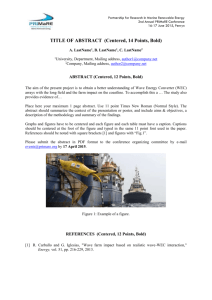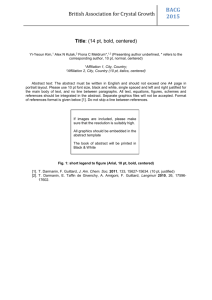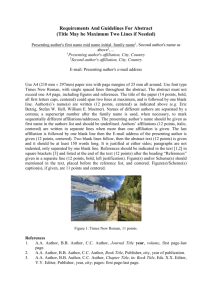Paper Format Guidelines
advertisement

PAPER MAIN TITLE FOR CONFERENCE ON GROUNDWATER : FROM THEORY TO ACTION [Times 14 point, bold, centered, upper case] I.M. Author1 and C.O. Author(s)2 [Times 12 point, bold, centered, upper and lower case] 1 Hard Knocks Laboratory, Department of Civil and Environmental Engineering, Research University City, State/Province, Country; email: imauthor@esu.edu [10 point, normal, centered, upper and lower case] 2 Everlasting Company Town, State/Province, Country; email: co.author@everco.com Abstract [Times 12-point, bold, centered and upper and lower case] These guidelines are for your conference paper. The papers will be produced on a CD-ROM that will be distributed to all delegates attending the conference and will have an official ISBN number. The manuscript must use a consistent one-column format on A4 size paper with a maximum length of 10 printed pages (including all text, graphics and appendices) and a maximum file size of 3 MB. The submission deadline of 30 June 2015 must please be adhered to. Submit the paper as an MS Word file by email to info@gwd.org.za. All papers must start with an abstract which presents a concise (half page maximum) statement of the scope, principal findings, and conclusions of the paper. Please do not page number the paper or use headers or footers. These guidelines are written in the correct format and may be used as a template. [Times, 11-point, upper and lower case, alignment justify. Abstract usually in one paragraph] 1. SECTIONS [Times, 12-point, bold, upper case, alignment left] All the pages of the paper should be A4, i.e. 210 x 297 mm (8.3 x 11.7 inches). All margins should adhere to the sizes given in Table 1 below. All the text must be single-spaced and in one-column format. The font must be 11 point Times, Times Roman or New Times Roman, including figures and tables. Leave two blank lines before the sections [Times, 11 point, normal, alignment justify, upper and lower case] Table 1. Margins for A4 size paper Margin Left Right Top Bottom A4 paper 25 mm 20 mm 30 mm 20 mm Subsection [Times, 12-point, bold, alignment left and capitalize first letters] Subsections are not numbered. The text included in the section or subsection must begin one line after the section or subsection title. Leave two blank lines (11 point) before the section title and one blank line before the subsection title. 2. PERMISSIONS If a figure, photograph, or table has been published previously, the author must obtain written approval from the original publisher. Please note that material obtained from the Internet (such as Google Earth, Mapquest or Encarta) is often copyright protected. While it is sometimes possible to get permission to use such material, this is often difficult and may be expensive. If you are using project or client information, please ensure in advance that you have the right or the necessary permissions to publish the material. 3. PAGE NUMBERS, HEADERS AND FOOTNOTES These elements are not allowed. 4. EQUATIONS, FIGURES AND TABLES All equations should be centered and embedded in the text. Equations need to be numbered only if they are referred to more than once. Stack numerators over denominators and leave one blank line between equations and text, and between two equations. For example: hf with Lv2 (2) 2gD 1 . 51 k 2 2 log 3 . 7 D Re All figures, illustrations, photographs and tables should be centered, numbered sequentially and include a caption. Captions for figures should be placed directly below the illustration (see Figure 1). Captions for tables should be placed directly above the table. All elements must be embedded within the document. Each figure should be mentioned or “called out” before it appears. More than one figure may appear on a page. Figure 1. Sample line art illustration 5. REFERENCING All references should appear together at the end of the paper (see below). References are listed alphabetically by last name of the first author. When two or more references by the same author are listed, year of publication is taken into account, and the earliest work is listed first. Wherever reference is made in the text to an author’s work, the author’s name and year of publication should appear in parenthesis, for example, (Fisher and Struik, 1974). All listed references must be cited in the text. Babovic, V., and Keijzer, M. (1999) “Data to knowledge – the new scientific paradigm.” Water Industry Systems: Modelling and Optimization Applications, Vol. 1, Savic, D.A., and Walters, G.A. (eds.), Research Studies Press, Baldock, UK, 3-13. Shamir, U., and Howard, C. (1968) “Water distribution systems analysis.” Journal of Hydraulic Engineering, 94 (HY1), 219-234. Todini, E. (2006) “On the convergence properties of the different pipe network algorithms.”, Proceedings of the 8th Annual Water Distribution Systems Analysis Symposium WDSA2006, Buchberger, S.G. (ed.), August 27-30, Cincinnati, Ohio, <http://scitation.aip.org/journals/doc/ ASCERL-home/proc/ CP_wdsas_login.jsp> (accessed April 1, 2008). Walski, T. (1984) Analysis of Water Distribution Systems, Van Nostrand Reinhold, New York. [Times, 11-point, normal, alignment justify, upper and lower case, hanging indent at 6.3 mm (0.25 inches)]








